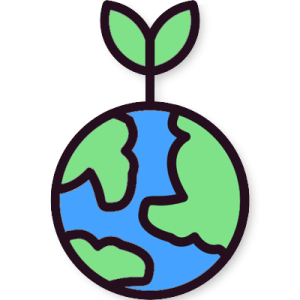
Overview
In this activity, students decide whether water should be granted legal rights. Students explore how Indigenous perspectives and relationships with water are influencing how water is viewed and protected.
Instructions
What you'll need
- "Should water have rights?" worksheet, one copy for each student
- "Granting water legal rights" handout, one for each group
- Organize your students into small groups (2-3 students). Ask groups to find an online version of the Canadian Charter of Rights and Freedoms; alternatively, click on this link to display the Canadian Charter of Rights and Freedoms.
- Begin the activity by asking groups to make a decision: should water have rights? Encourage students to refer to the Charter, and to identify any rights from the Charter that water should have protected.
- Invite groups to share their decisions and thinking with the class.
- Provide each student with a copy of the "Should water have rights?" worksheet. Prompt students to work individually and to write down their own decision about granting water rights. Encourage students to describe what information or ideas might cause them to change their initial thinking.
- Organize your students into small groups (2-3) and provide each group with a copy of the "Granting water legal rights" handout. For each example, ask groups to identify the main arguments and ideas that were used to support grating water legal rights. Alternatively, assign each group one of the examples of water receiving rights.
- Encourage groups to share their thinking with the class. As they share, lead a discussion focused on questions such as:
- Which perspective of water supports water having legal rights: a biotic perspective or an abiotic perspective?
- Which legal rights did water receive?
- How might granting water legal rights change peoples’ relationships with water?
- Why is it important to consider the perspective of Indigenous Peoples when thinking about the rights of water?
- Guide your students’ attention back to their worksheets and ask them to revisit their initial thinking about granting water legal rights: What would they add to or change about their initial thinking? What changes to the Canadian Charter, if any, would they recommend be made to protect water?
- Conclude the activity by revisiting the question, “Should water have legal rights?” Ask your students to suggest any important benefits and challenges related to granting water legal rights. As you discuss, encourage your students to support their thinking with ideas from this activity.
Modify or extend this activity
Modifications
- Consider showing this video from the NCSA (National Counselling services of Alberta) to explain Indigenous understandings of the interconnectedness of nature.
- Consider showing this video of a traditional Indigenous water blessing ceremony on the Salish Sea by the T’Sou-ke Nation to help students understand the sacred nature of water.
- It might be helpful to show this video in Step 7 to introduce the examples of water being granted legal rights.
Extensions
- Hold a U-shaped discussion on the question of “Should water receive legal rights?”
- Invite a local First Nations community member to come into your class to share local Indigenous knowledges about water and water stewardship.
- Have students create a case for protecting the rights of a local river.
- Ask students to develop amendments that could be made to the Canadian Charter of Rights and Freedoms to better protect water.
Curriculum Fit
Environmental Science 11
Big idea
- Humans can play a role in stewardship and restoration of ecosystems
Content
- Abiotic characteristics:
- Aquatic
- Atmospheric
- Edaphic
- Levels of biotic diversity
- First Peoples knowledge and other traditional ecological knowledge in sustaining biodiversity
- Benefits of ecosystem services
- Human actions and their impact on ecosystem integrity
- First Peoples ways of knowing and doing
- Resource stewardship
Curricular competencies
Questioning and predicting
- Demonstrate a sustained intellectual curiosity about a scientific topic or problem of personal, local, or global interest
Processing and analyzing data and information
- Apply First Peoples perspectives and knowledge, other ways of knowing, and local knowledge as sources of information
Evaluating
- Demonstrate an awareness of assumptions, question information given, and identify bias in their own work and in primary and secondary sources
- Consider social, ethical and environmental implications of the finding from their own and others’ investigations
Applying and innovating
- Contribute to care for self, others, community, and world through individual or collaborative approaches
Communicating
- Communicate scientific ideas and information, and perhaps a suggested course of action, for a specific purpose and audience, constructing evidence-based arguments and using appropriate scientific language, conventions, and representations
- Express and reflect on a variety of experiences, perspectives, and worldviews through place
Assessments
Throughout the activity, consider how well students:
- Identify different perspectives.
- Use evidence to make decisions.
- Contribute to group discussions.
Teaching Notes
For more details, read the Canadian Charter of Rights and Freedoms.
The term, environmental personhood, is a legal concept that assigns certain environmental entities (e.g., rivers, trees) the status of a legal person. This assigns to these entities the rights, protections, privileges, responsibilities, and legal liability of a legal personality. This concept came from legal cases focused on the protection of nature, often through Indigenous worldviews.
The following websites might be helpful in starting and guiding thinking around water being granted legal rights:
- Rivers get human rights: They can sue to protect themselves
- Should rivers have the same legal rights as humans?
- Should nature be given legal rights?
How this activity was developed
These materials were created with guidance from Indigenous educators, subject matter experts and thought leaders to help draw upon important teachings, learnings, and Indigenous perspectives.
For centuries, the traditional western view of water has often been focused on its value as a resource. Indigenous people have a unique relationship with the waters of British Columbia. Since time immemorial, water has played a sacred role and is seen as a living entity. How water is used must be carefully considered with a view towards not just the immediate need and impact, but the needs and perspectives of generations to follow.
We are dedicated to deep listening and respectfully highlighting Indigenous ways of knowing in the materials we provide B.C. educators. If you have any feedback for us on these activities, or suggestions for others, please email schools@bchydro.com. We would love to hear from you.
About the artist
The design of the worksheets in this activity was a collaborative effort with Indigenous artist Kelli Clifton. Kelli Clifton was born and raised in Prince Rupert, British Columbia and is Gitga’at from the community of Hartley Bay. Clifton is interested in using her artwork as a form of storytelling—especially in relation to her Ts’msyen language (Sm’algyax), her coastal upbringing and her experiences as an Indigenous woman. Clifton currently lives in her home community where she continues to practice her art and teaches Sm’algyax at a local high school. Learn more about Clifton's art on her Facebook page.
BC Hydro’s commitment to reconciliation
BC Hydro exists to serve British Columbians by providing clean, reliable and affordable electricity. We recognize that maintaining and developing the system has impacts on the lives and interests of Indigenous People. To support our move towards true and lasting reconciliation, BC Hydro will acknowledge past wrongs, listen to Indigenous perspectives and seek shared understanding with First Nations communities and governments.
Learn more about our Statement of Indigenous Principles.








